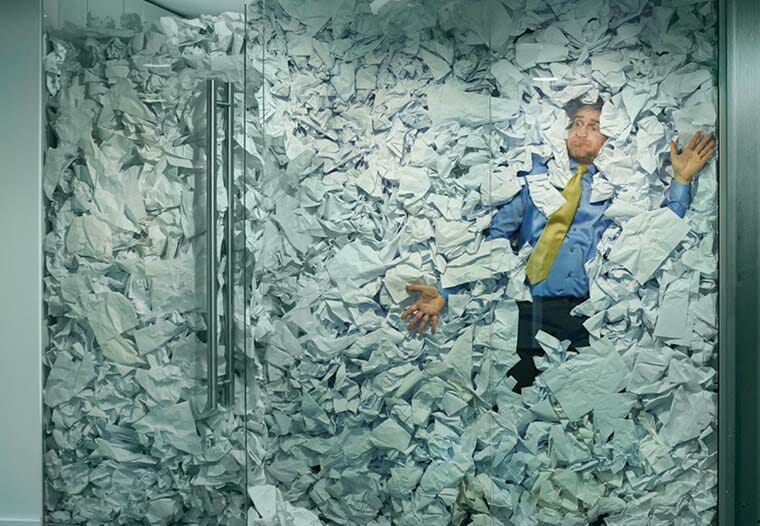How going paperless makes you a better employer




But look closely: even in organisations that boast about innovation and proclaim their digitally enlightened credentials, you’ll find stacks of paper receipts, payslips, paper invoices, and forms.
In cupboards, drawers, and filing cabinets around the country, many of the HR information and processing that’s done day to day still takes place on paper documents in brick-and-mortar offices.
Turns out, taking the initiative to go paper free is harder than completing dry January. Unfortunately, though, it’s a fundamental component of digital transformation.
So why is a transformation from paper-based to paperless so important for businesses today?
Read on to learn why it’s time for your company’s digital transformation.
What exactly does going paperless mean?
Going paperless as an employer means that you are replacing physical documents and manual processes with digital technologies that can store, automate, and otherwise enhance your business processes.
Instead of filing systems full of paper forms, paperless offices use the cloud to store digital information. Businesses that undergo this transformation to paperless offices no longer need to print and file information manually.
To create a paperless office, many businesses have already used XCD’s automated HR and Payroll software, but more on that later.
First of all, what’s the problem with relying on paper documents?
Here are some of the reasons not using digital technology to go paperless is holding you back.
Time
When your document management all uses paper, maintaining, filing, transposing, copying and generally processing paper documents is a manual, laborious, repetitive task. Reports aren’t generated, they’re painstakingly assembled by hand.
Not to mention, if a person has to manually print, scan, and file documents it can lead to bottlenecks in HR departments. One of the best parts of a company’s digital transformation is how much time it frees up for HR employees to focus on more important, value-adding work.
Accuracy
Data transfer in a paper world relies on human beings and their ability to manually copy information from one place to another, digit by digit, without making a mistake. Not going to happen.
We try our best but humans are prone to errors. We might misfile documents or mistype numbers, creating huge headaches for the potential hires whose applications get lost, or employees whose mistyped bank details mean they don’t get paid on time.
That’s why technology can be the best solution for ensuring accuracy. Paperless processes make it far less likely that human errors will creep into your business processes.
Accessibility
It’s easy to list the ways information in paper files is accessible. There’s one way and it involves a person with the document sat in front of them. So when it’s Sunday and your CEO needs that data immediately to stave off an emergency, you’d better get in the car…
Beyond the benefits of being able to access digital versions of your documents from anywhere in the world, it’s useful that different people can access and work on the same documents and processes at the same time, with any changes being instantly updated across the entire system.
With the rise of remote working resulting from the Covid-19 pandemic, it’s more important than ever that your files are accessible outside of the office.
Service Levels
“Can you tell me how much holiday I have left please?” Yes, I’ll have to rifle through these filing cabinets. Or, “Can I have a report on H1 employee retention and a forecast for the rest of the year please?” Of course, sir. I’ll get back to you in two weeks.
Paper still works. It’s worked for decades, centuries. But there are faster ways to do things, so if improvement and competitiveness is part of your organisational strategy, buying into the digital transformation trend makes more sense. Thanks to the innovations of technology which uses the capabilities of the cloud and artificial intelligence, paper processes should be on the guillotine.
You might be interested in: 5 ways to get the most out of your HR technology
So what’s the alternative?
In short, the alternative for your company is a digital transformation.
This involves using digital technologies to automate the previously paper-based processes, moving away from physical documents to digital storage. This allows you to store all information electronically, reducing the company’s reliance on paper, and streamlining processes.
Say goodbye to printing, poor quality document scans, and fussing with file cabinets. A digital transformation makes your organisation more efficient, agile, and productive.
Using technology to transform your business into a paperless enterprise may seem like a lot of effort. However a digital transformation has myriad benefits that make taking the initiative to create a paperless office worthwhile.
Here’s a run-down of some the benefits of HR becoming a paperless office
Transformation of recruitment
With a digital system, candidates can apply online, meaning their details are immediately available to hiring managers and recruitment decision makers. With no need for paper copies of CVs and forms, it’s easier for employers to keep track of who is applying to join the company. Plus, if HR staff are already storing all this information digitally, it’s even easier to automate reminders to and digital communications about recruitment.
At the interview stage, interview results can be efficiently collated and reviewed by all stakeholders, making it easier to identify the top talent who should join the company. Plus, your business will stand out to potential hires if the process feels digital-savvy and streamlined rather than clunky and paper-based. This is new employees’ first impression of your business after all – you want to stand out, and ditching paper in favour of digital technology is always a plus.
You might be interested in: How expense management software reduces HR headaches
Digitize onboarding
Usually, there’s a lot of paperwork involved in hiring and onboarding, and new employees will have to waste a lot of time filling out forms. In contrast, when your system is paperless, new starters already exist on the system from where they filled out their personal information as part of the application process, and where they have already had a chance to view the important policy documents. Job offers and contracts can be automatically generated and shared.
Using technology to get this admin out of the way before new hires even start means that they can have a smoother onboarding process and settle in faster with co-workers and other team members. Streamlining onboarding through digitization is therefore good for cost-saving and productivity.
Streamline reward and remuneration
Paperless Payroll is a gamechanger for processing. Electronic timesheets and automatic tax and pension calculations, updated salary changes, bonuses and other payments, cut days from the task.
By using cloud-based HR and Payroll software like XCD’s system, payroll administrators can be sure that employees’ personal and bank information is up to date and there are no errors.
Transferring to digital payslips immediately removes a huge cash and administrative cost. Plus, it’s useful for employees who can log on and view their up-to-date payslips from anywhere and at any time.
Transform performance
Paperless performance management allows organisations to move away from the arduous and outdated annual appraisal approach, to a more modern system of constant two-way conversation and feedback.
When all of the data about an employee’s performance is collated in one place and is accessible with the click of a button, it’s much easier to track performance and employee engagement. Top performers no longer slip under the radar and it’s easier to identify employees’ skill gaps and issues – all things that are useful for performance management.
You might be interested in: The importance of employee appraisals
Access data-driven reporting and analytics
When all your people data is held on a modern digital system of record, reports that might’ve taken HR professionals days to assemble can be compiled in seconds. Analytics can help you spot trends and unearth workforce insights that put HR ahead of the game and able to make a positive, valuable contribution to organisational strategy.
Reduce environmental impact with paperless processes
Don’t forget that moving from a paper-based system to a digital document management system massively reduces the environmental costs of printing, storing, and even transporting documents. With everything stored in the cloud and accessible from desktop and mobile, there’s no need for any of that.
Start your paperless digital transformation today
We may be biased, but here at XCD we can’t imagine doing our most important business processes using physical documents.
That’s why we see our HR and Payroll automation technology as the best solution. In our opinion, digital HR software allows you to get the best out of a company.
We’ve already helped many businesses boost productivity and revenue with their digital transformations. Check out some of our case studies to learn how we helped businesses make their processes digital.
Interested in finding out what your company’s paperless digital transformation could look like?
Get in touch or book a demo now.





